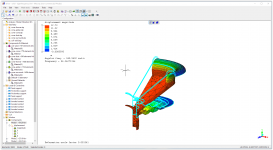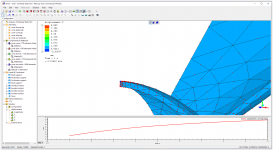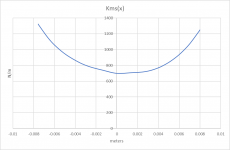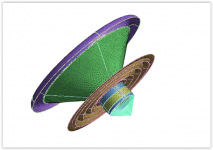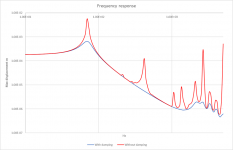Most of us would not have access to tools such as COMSOL Multiphysics for driver design or analysis. This is not a road block. There are open-source or affordable tools to accomplish the task. We many need more than one tools instead of a single-suite. For motor design, FEMM is my definite choice. It is free and powerful. We can get, DCR, BL0 (resting BL), BL(x) (BL versus coil displacement) as well as blocked impedance (e.g. coil inductance) of voice coil.
Regarding mechanical domain of the design, Lisa or Mecway is an affordable one. In the following, Mecway is used.We can do eigen-analysis (modal-analysis) of the moving parts (diaphragm/cone, surround, spider) to determine resonance frequency of the driver. From this analysis, we can also know at what frequency cone break-up begins. Suspension stiffness versus displacement, Kms(x), can be predicted.
If the driver is aimed for piston/rigid operation, we essentially have all the data to build a lumped model for acoustic simulation. Give the availability of BL(x) and Kms(x), nonlinearity of the driver can be evaluated. Distortion due to BL(x) and Kms(x) can be obtained.
A hypothetical woofer is used in the following Mecway modal simulation. A quarter of the 3D-solid model is used to reduce complexity. The model is initially created in a 3D CAD tool. It is exported to STEP for Mecway importing. Since fundamental frequency is target of this simulation, the use of symmetry planes is acceptable. The fundamental (resonance) frequency of this mode is 54.3 Hz as shown in the figure.
Regarding mechanical domain of the design, Lisa or Mecway is an affordable one. In the following, Mecway is used.We can do eigen-analysis (modal-analysis) of the moving parts (diaphragm/cone, surround, spider) to determine resonance frequency of the driver. From this analysis, we can also know at what frequency cone break-up begins. Suspension stiffness versus displacement, Kms(x), can be predicted.
If the driver is aimed for piston/rigid operation, we essentially have all the data to build a lumped model for acoustic simulation. Give the availability of BL(x) and Kms(x), nonlinearity of the driver can be evaluated. Distortion due to BL(x) and Kms(x) can be obtained.
A hypothetical woofer is used in the following Mecway modal simulation. A quarter of the 3D-solid model is used to reduce complexity. The model is initially created in a 3D CAD tool. It is exported to STEP for Mecway importing. Since fundamental frequency is target of this simulation, the use of symmetry planes is acceptable. The fundamental (resonance) frequency of this mode is 54.3 Hz as shown in the figure.
Attachments
A y-axis force constraint is applied to the coil elements. The force is varied from 0 to 10N (or 0 to -10N) in nonlinear quasi-static simulation (CCX solved employed). The solver takes care nonlinearity of large deformation (surround and spider). Displacement of the dust cap is not a linear function to the applied force. If we export the data to excel, we can obtain Kms vs displacement as shown. As shown, the suspension (surround and spider) stiffness at resting is about 700 N/m. Symmetry of it is not perfect. The coil-in direction is a bit stiffer.
We can fine tune the surround and/or spider geometry to optimize the Kms(x).
We can fine tune the surround and/or spider geometry to optimize the Kms(x).
Attachments
Holy simulation doesn't allow to have no proper understanding.
Nowaday speakers are critically depends of cone material rigidness, suspension mechanical losses and coil thermal size margins.
You speak nothing about.
Why simulate spherical horse in vacuum while most of the needed data are unknown?
There are well-knowm mass breakup, there are well known cone diffraction and radiation focusing, there are well known uglyness of the resin suspension.
Nowaday speakers are critically depends of cone material rigidness, suspension mechanical losses and coil thermal size margins.
You speak nothing about.
Why simulate spherical horse in vacuum while most of the needed data are unknown?
There are well-knowm mass breakup, there are well known cone diffraction and radiation focusing, there are well known uglyness of the resin suspension.
Most of us would not have access to tools such as COMSOL Multiphysics for driver design or analysis. This is not a road block. There are open-source or affordable tools to accomplish the task. We many need more than one tools instead of a single-suite. For motor design, FEMM is my definite choice. It is free and powerful. We can get, DCR, BL0 (resting BL), BL(x) (BL versus coil displacement) as well as blocked impedance (e.g. coil inductance) of voice coil...
LISA and MECWAY are great. I haven't used them in a long long time... maybe 6 or 7 years since I last used it. I've been thinking about buying the latest versions though as it's a much more useful program compared to what I have been useing for the last few years. They are inexpensive and very powerful.
I see you've applied material properties for the different components... very good. What materials did you use? As in... how did you apply any fabric material such as for a spider or suround...??? Or how did you account for impregnated fabric? Or did you have some other homogenous material you worked with?
Also, I am sure LISA and MECWAY can do some other things too...
I see you've applied material properties for the different components... very good. What materials did you use? As in... how did you apply any fabric material such as for a spider or suround...??? Or how did you account for impregnated fabric? Or did you have some other homogenous material you worked with?
I used the material parameters of the COMSOL example Loudspeaker Driver Tutorial Model in the Mecway model.
I do static and dynamic test to estimate basic mechanical properties of materials (spider, surround, diaphragm).
Mecway/Lisa doesn't have frequency domain solver. We would need to use many dynamic response runs to obtain the response. Displacement data of each run can be exported to software like AKABAK 3 (boundary element solver) to make acoustic simulation.
The model in Mecway is also imported to another FEA code, midasNFX. Shell elements are used for all parts (except coil) of the driver. Coil is in solid elements. Full 3D geometry is considered since resource for using shell is relatively minimal compared to solid. It would take long time and huge memory size. Direct frequency response is used to obtain max. displacement vs frequency as shown in the figure.
The model in Mecway is also imported to another FEA code, midasNFX. Shell elements are used for all parts (except coil) of the driver. Coil is in solid elements. Full 3D geometry is considered since resource for using shell is relatively minimal compared to solid. It would take long time and huge memory size. Direct frequency response is used to obtain max. displacement vs frequency as shown in the figure.
Attachments
Last edited:
http://midasnfx.pansonaudio.com/full-shell%20vib%20at%203230Hz.avi
This video shows the cone vibration at 3230 Hz.
This video shows the cone vibration at 3230 Hz.
Dear Panson, that's all great, but forget about such an emulating.
First, you need to understand your's company possibilities in using modern suspension materials and their impregnation. Next you need to understand modern cone material rigidness and a ways of their enhancements. The last you need to understand the modern coil wounding methods including coil former material rigidness being steressed at a high temperatures/power.
Until such an understanding there are a huge couple of problems which in case limits your simulation at a hard-driven conditions.
First, you need to understand your's company possibilities in using modern suspension materials and their impregnation. Next you need to understand modern cone material rigidness and a ways of their enhancements. The last you need to understand the modern coil wounding methods including coil former material rigidness being steressed at a high temperatures/power.
Until such an understanding there are a huge couple of problems which in case limits your simulation at a hard-driven conditions.
Hi Bes,
I can't agree more for your points. Without proper material parameters, the FEA results would be questionable. Getting material parameters is always a challenge to us. Suppliers may not able to feed us the data needed for FEA. Static vs dynamic is another challenge. Most of the time we can just obtain static parameters. Dynamic measurement by, e.g. DMA is expensive, limited or simply not available.
These obstacles are not blocking us to use FEA as long as we know the limitations and carefully interpret the results. Using basic material parameters, we can have initial design made. We know some basics of the design. This is an important stepping stone of the following steps.
We do see good correlation between simulation models and prototypes. But nothing is perfect. Tweaking, fine tuning ... never end.
I can't agree more for your points. Without proper material parameters, the FEA results would be questionable. Getting material parameters is always a challenge to us. Suppliers may not able to feed us the data needed for FEA. Static vs dynamic is another challenge. Most of the time we can just obtain static parameters. Dynamic measurement by, e.g. DMA is expensive, limited or simply not available.
These obstacles are not blocking us to use FEA as long as we know the limitations and carefully interpret the results. Using basic material parameters, we can have initial design made. We know some basics of the design. This is an important stepping stone of the following steps.
We do see good correlation between simulation models and prototypes. But nothing is perfect. Tweaking, fine tuning ... never end.
Very interesting. Somewhat in line with the remarks of BesPav: are there tricks to simulate a non-homogenous cone construction? I am not talking about sandwich cones, but about e.g. the Scan-Speak slitting of a cone or having 3 leaf clover pattern reinforcement of the cone to diminish the break up effects of a solid homogenous cone? (Most simple to start with should be the simulation of stiffer or less stiff cone termination, such as e.g. in the Peter Larsen Loudsoft demo clips)
e.g. the Scan-Speak slitting of a cone or having 3 leaf clover pattern reinforcement of the cone to diminish the break up effects of a solid homogenous cone?
It should be entirely possible even with the Mecway. Probably one could use an expensive woofer with mods to verify the reinforcement design, simulation vs measurement.
It should be entirely possible even with the Mecway. Probably one could use an expensive woofer with mods to verify the reinforcement design, simulation vs measurement.
I'll recommend not to try to simulate midband in the freq area of size-depending Fresnel mode.
Piston size in the low-freq speakers must be properly sized. It'a nonsense to try 15" woofer to effectively reproduce 2-3 kHz.
But while in the proper low-freq range you need to know only are your cone stiff enough.
Hello BesPav,
My questions are not aimed at squeezing the best or even the impossible out of a particular driver, but rather at in-depth analysis of cone+ surround behaviour and break up patterns.
So the questions are more directed at midrange behaviour than bass. Pistonic is basically boring, although there is such a thing as cone rocking or wobbling below 20Hz.
Would be great if that could be simmed. There is more than just stiffness to that.
My questions are not aimed at squeezing the best or even the impossible out of a particular driver, but rather at in-depth analysis of cone+ surround behaviour and break up patterns.
So the questions are more directed at midrange behaviour than bass. Pistonic is basically boring, although there is such a thing as cone rocking or wobbling below 20Hz.
Would be great if that could be simmed. There is more than just stiffness to that.
- Status
- This old topic is closed. If you want to reopen this topic, contact a moderator using the "Report Post" button.
- Home
- Design & Build
- Software Tools
- Affordable tools for loudspeaker driver design and analysis
